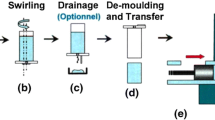Abstract
The effects of different Si and Cr contents on the microstructure and mechanical properties of new type aluminum alloy with low silicon content were studied by means of hardness test, tensile test and metallographic preparation, SEM, EDS and DSC. The results showed that when the Si content increased gradually, the hardness and tensile strength increased first and then decreased. When the Si content was 3.5%, the hardness and tensile strength reached the maximum. The microstructure observation showed that when the Si content was 3.5%, the microstructure was the most fine and dense, and the secondary dendrite arm spacing (SDAS) of the alloy had the minimum value. When the content of Cr element increased gradually, the tensile strength and elongation showed a trend of increasing gradually, and the maximum value was obtained at 0.5%. When Si was 3.5% and Cr was 0.5%, the best mechanical properties were obtained. At this time, the microstructure of the alloy was fine, dense and uniform, and Mg2Si strengthening phase was precipitated during heat treatment. Cr element has the functions of solid solution, fine crystal and dispersion strengthening. Therefore, the tensile strength, yield strength and elongation of the new aluminum alloy were 350.7 MPa, 303.0 MPa and 8.56%, which has obvious advantages over the traditional cast Al-Si alloy.















Similar content being viewed by others
References
Dioni D, Cecchel S, CornacchiG, T. Nonferr. Metal. Soc.25(2015) 1035.
Barbosa C R, Machado G H, Azevedo H M, Met. Mater. Int.26(2020) 370.
Ma S, Wang Y, Wang X, Journal of Alloys and Compounds792 (2019) 365.
Song Z, Wei F, Engineering Technology: Full-text version7 (2016) 259.
Güneren A, Dokumacı E, Int. J. MetalCast.14 (2020) 580.
Zhong H, Rometsch P A, Cao L, Mater. Sci. Eng. A651 (2016) 688.
Peng J H, Tang X L, He J T, T. Nonferr. Metal. Soc.21(2011) 1950.
Zhang J X, Gao A H, Chen W. Foundry Technology28(2007) 373.
Liao H C, Ding Y, Sun G X, T. Nonferr. Metal. Soc.14(2004) 728.
Li J S, Qu M, Cui Y, Heat Treatment of Metals, 41(2016) 69.
Li Z, Zhang Z, Chen X G, Mater. Sci. Eng. A708 (2017) 383.
Zhang B R, Tian S J, Wang H Y, Foundry Technology30(2008) 1367.
Jiang D M, Zhang Y P, Light Alloy Processing Technology29(2001) 1.
Rao X X, Heat treatment strengthen technoloy Research of A356 cast Aluminum Alloy, Master's Thesis, Huazhong University of Science and Technology, China (2007).
Remoe M S, Marthinsen K, Westermann I, Mater. Sci. Eng. A693(2017) 60.
Školáková A, Novák P, Vojtěch D, Kubatík T F, Mater Design107(2016) 491.
Acknowledgements
This article is written within the framework of the Chinese National Key R&D Project “Integration and development of light weight electric drive chassis angle module,” Project No.2018YFB0104804.
Author information
Authors and Affiliations
Corresponding author
Additional information
Publisher's Note
Springer Nature remains neutral with regard to jurisdictional claims in published maps and institutional affiliations.
Rights and permissions
About this article
Cite this article
Cheng, T., Li, P., Lu, F. et al. The Improvement in Mechanical Properties and Strengthening Mechanism of The New Type of Cast Aluminum Alloy with Low Silicon Content for Automotive Purposes. Trans Indian Inst Met 75, 1245–1254 (2022). https://doi.org/10.1007/s12666-021-02479-0
Received:
Accepted:
Published:
Issue Date:
DOI: https://doi.org/10.1007/s12666-021-02479-0




